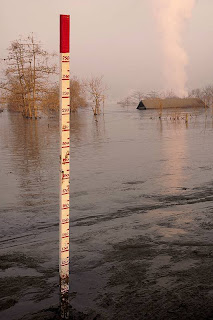Sidoarjo mud flow or Lapindo mud or mud in Sidoarjo (Louise), is the outburst events of hot mud at the site of PT Lapindo Brantas drilling in Renokenongo Village, Porong district, Sidoarjo regency, East Java, since May 27, 2006. Blast of hot mud for several months causing sink of settlements, agriculture, and industry in the three districts in the vicinity, and to influence economic activity in East Java.
Sidoarjo mud flow or Lapindo mud or mud in Sidoarjo (Lusi), is the hot mud events at the site of PT Lapindo Brantas drilling in Renokenongo Village, Porong district, Sidoarjo regency, East Java, since May 27, 2006. Blast of hot mud for several months causing tergenangnya settlements, agriculture, and industry in the three districts in the vicinity, and to influence economic activity in East Java.

Mudflow termination scenario
There are those who say this mudflow could be stopped, with some scenarios below, but the assumption could surge halted until the year 2009 did not work at all, which defines this surge is a phenomenon of nature. The first scenario, stop the flood of mud by using the well snubbing unit at Banjar Panji-1. Snubbing unit is a hydraulic system powered devices are generally used for well-intervention work & Workover (doing a job into an existing wells). Snubbing unit is used to achieve a series of drills weighing 25 tons and 400 meters long is left on the early drilling. It is expected that when the drill is found then it can be pushed into the well (9297 feet) and then injected into the well covered with cement and mud weight. However, this scenario a total failure. Drill sequence is found at depths of 2991 feet but failed snubbing units pushed into the bottom of the well.
The second scenario is done by drilling sideways (sidetracking) drill bit to avoid the left. Drilling carried out by using the rig owned by PT Pertamina (Persero). This second scenario also fails because the damage has been found in some depth the veil between 1060-1500 feet, and the lateral movement of the drilling location BJP-1. Conditions that complicate the implementation of sidetracking. Also appeared bubbles in natural gas drilling locations feared endangering the safety of workers, the height of the dike around the drilling location has been more than 15 feet from the ground so that no longer worthy to be exalted. Therefore, Lapindo Brantas carry out permanent closure of BJP-1 well.
The third scenario, at this stage, the extinction of mud made by first making three new wells (relief well). Three locations are: First, about 500 meters southwest of the Well Banjar Panji-1. Second, about 500 meters west northwest of Banjar Panji 1 well. Third, approximately north-east of the Well Banjar Panji-1. Until now, this scenario is still running.
All three scenarios depart from the hypothesis that the mud came from a crack in the wall of the well Banjar Panji-1. And there is another hypothesis, that is happening is a phenomenon of the mountain of mud (mud volcano), as in bramara Kuwu in Purwodadi, Central Java. Until now, continue to spew Kuwu bramara slab to form a swamp.
Rudi Rubiandini, First Team member, said that the mountain of mud can only be resisted by operating four or five relief well at the same time. All the wells are used to surround the cracks where the mud out. This job barriers and time-consuming expensive. For example, a rig (drilling rigs) operating costs below USD 95 billion needed. Costs can swell due to contractors and drilling equipment rental charges are usually more expensive in dangerous territory. At least five wells will need USD 475 billion. We have had trouble getting the unemployed rig amid soaring oil prices.
Dwi Rovicky Putrohari, an independent geologist, wrote that the location of wells Porong-1, seven miles east of Banjar Panji-1, there were signs that show geological mudflow in ancient times, so his analysis. Rovicky noted a worrying thing: in Porong mudflow stopped within the period of tens to hundreds of years.

Only Happen in Indonesia


No comments:
Post a Comment